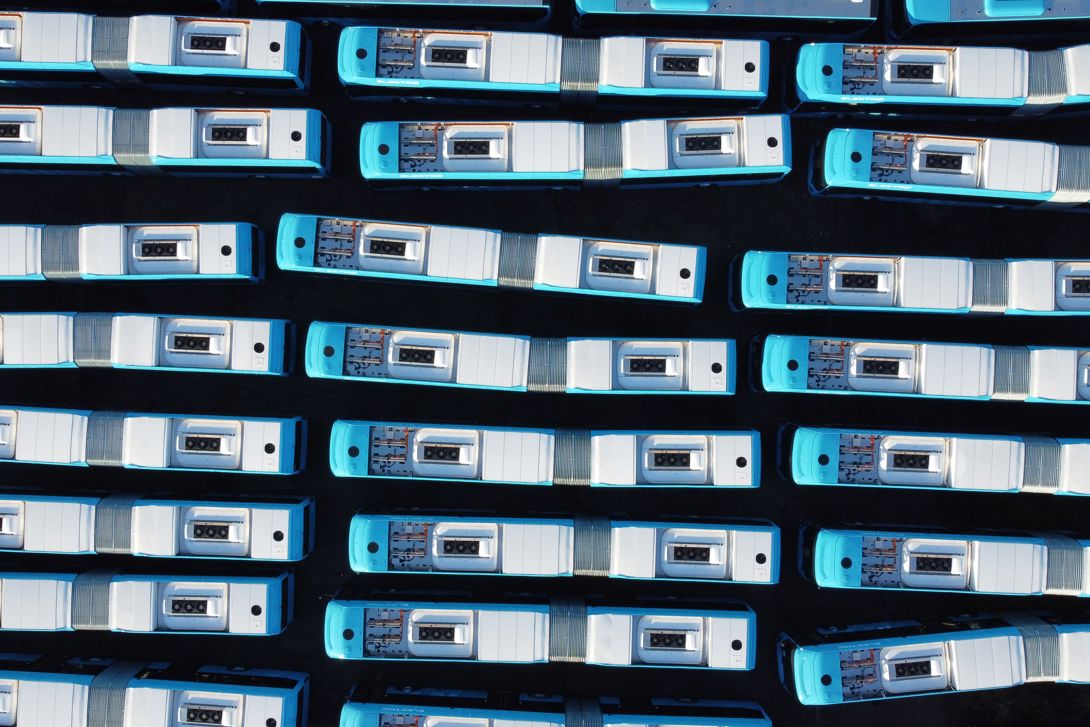By 2030, all city bus services within Västtrafik will be electrified. We have already come a long way in the transition and are leading the way in the development of electrified traffic. By the end of 2020, we will have the most electric buses in the Nordic region.

Now we electrify the West of Sweden
Why we electrify
In order to make sustainable travel even more sustainable and reach Västtrafik's high climate goals, we are now electrifying our traffic. Through large-scale electrification of public transport, we can achieve our target of a 90% reduction in CO2 emissions by 2035.
Modern, attractive and electric vehicles also mean that more people choose to travel sustainably together with us.
Electrified city bus traffic also reduces noise and emissions. With better air and less noise, we can build attractive and sustainable cities for the future.
Here we drive electric buses
In 2019, Västtrafik rolled out 60 electric buses in several locations in the Västra Götalands region. Since then, hundreds of electric buses have rolled out across the region. By 2030, all our city bus services are expected to be electrified.
2024
- Kungälv: All urban area traffic will receive electric buses in October. Total of 7 electric buses.
2023
- Stenungsund: All urban area traffic will receive electric buses in August. Total of 4 electric buses.
- Trollhättan: All city traffic will receive electric buses in December. Total of 32 electric buses.
- Vänersborg: All city traffic will receive electric buses in December. Total of 15 electric buses.
- Gothenburg: 63 electric buses start operating the trunk bus lines and the city traffic in City Center/North west from June.
- Gothenburg/Mölndal: 42 electric buses start operating in the flex traffic.
2022
- Gothenburg: 80 electric buses began operating the trunk bus lines and in City Center/North west areas from June onwards.
- Mölnlycke: All urban area traffic was electrified. Electric buses began operating the lines 1, 2 and 3.
2021
- Öckerö: 6 electric buses started running on lines 1, 2 and 3 in February.
2020
- Kungsbacka: 3 electric buses started operating in June.
- Gothenburg: Electric buses in the area of Gothenburg southwest and on line 58 December 2020.
- Partille: All city traffic will receive electric buses in December 2020.
- Mölndal: All city traffic will receive electric buses in December 2020.
Here are the bus routes electrified in December
2019
- Ale: 5 electric buses run on lines 402, 403, 404 and 411 since 2019.
- Borås: 10 electric buses run on line 2 since summer 2019.
- Gothenburg: 30 electric buses run on lines 59, 60 and 62 since autumn 2019.
- Lidköping: The entire city traffic has been electrified since summer 2019. A total of 11 buses on lines 1, 2 and 9.
- Uddevalla: 4 electric buses run on lines 1 and 4 since summer 2019.

Electric ferries
In November 2019, Västtrafik's first electric hybrid ferry Elvy started to cross the Göta älv. The ferry, which runs on line 286 between Stenpiren and Lindholmen, can run on electricity for about four hours. When the battery has run out, it can be charged during operation or with electricity at the quay.
Battery operation in the ferry reduces emissions of carbon dioxide, nitrogen oxides and particulate matter by a third. With the new technology, fuel savings are estimated to be up to 45 percent.
In 2022 we also began operating the electric hybrid ferry Eloise across Göta älv.
In 2024 the line 847 between Lysekil and Skaftö will begin to operate with an electric ferry.

Sustainability of electric buses
Västtrafik invests heavily in electrifying its traffic in order to reduce emissions and noise.
An electric bus saves about 80 percent energy compared to a regular diesel bus. In addition, they are completely free of emissions and significantly reduce noise levels, which is an advantage for both travellers, drivers and those living in the city.
The issue of battery production is often topical in the case of electric vehicles. While it is possible to use natural resources to produce a battery, the environmental impact is compensated by less emissions during the life of the bus. The environmental impact of battery production also differs depending on the composition of the battery and supplier, which is determined by the bus manufacturers.
In order to be able to influence further on this issue and get more sustainable supply chains, Västtrafik has co-founded ETI Sweden (Ethical Trading Initiative Sweden). The focus of the organization's work is human rights, workers' rights and the environment and climate. We also work closely with our colleagues at Skånetrafiken and SL to set common requirements in our procurements.

Background
Public transport has been electric for longer than people think. Gothenburg's trams have been electric since 1902 and over the years they have also in many ways rolled trolleybuses.
The investment in electrification that Västtrafik is now making is based on important experiences from their electricity test and demo arena. Since 2015, we have been driving electric buses on lines 16 and 55 in Gothenburg, in a collaboration between academia, industry and the public.